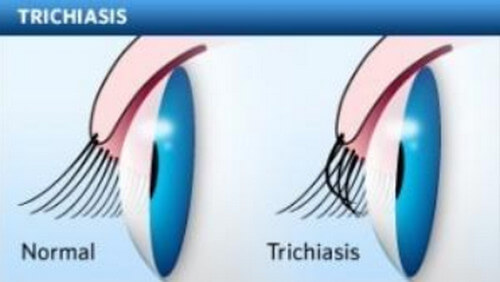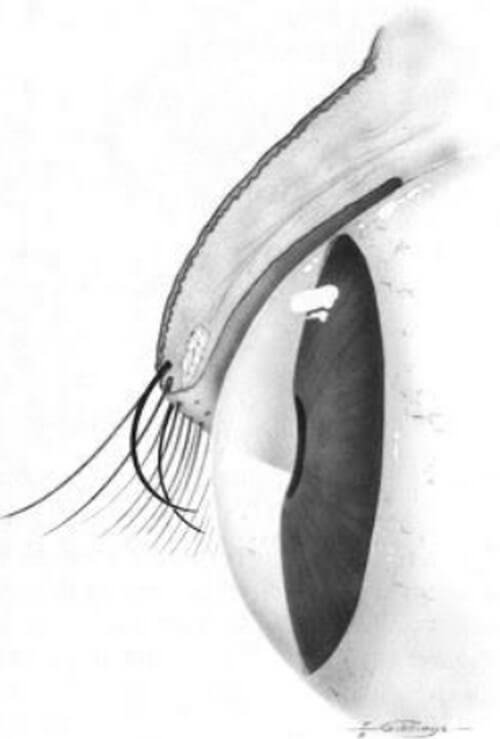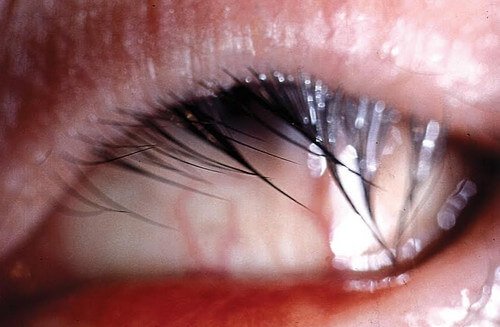Definition of Trichiasis
Trichiasis (pronunciation: \tri-ˈkī-ə-səs\; ICD-9: 374.05), a very common abnormality of the eyelid, refers to an ingrown eyelash.
The eyelashes come from their usual normal origin but in this case, the hair is directed inward toward the eye. This causes continuous eye irritation, pain, redness, among other symptoms [1–3].
Imagine something that is consistently poking your eye throughout the day. It is very annoying and it warrants a consultation to an ophthalmologist because your eyelashes, which are normally supposed to protect your eyes, may be the reason for you to get blind.
Trichiasis is often associated with the terms dischiasis and entropion. While trichiasis refers to inversion of eyelashes towards the eyes, dischiasis refers to an extra line of eyelashes at the back of the eyelid and entropion refers to inversion of the eyelid itself, not the eyelashes. However, there are instances wherein trichiasis and entropion occur at the same time [4].
Pictures of Ingrown Eyelash

Picture 1: Normal Eyelashes vs. Trichiasis or Ingrown Eyelashes
Image Source: ocvermont.com

Picture 2: Trichiasis or Ingrown Eyelashes
Image Source: medical-dictionary.thefreedictionary.com

Picture 3: Trichiasis or Ingrown Eyelashes
Image Source: cehjournal.org

Picture 4: Trichiasis or Ingrown Eyelashes
Image Source: eyesurgeryinberkshire.co.uk

Picture 5: Trichiasis or Ingrown Eyelashes
Image Source: mooreyecare.co.uk

Picture 6: Trichiasis or Ingrown Eyelashes
Image Source: mscharf.ipower.com
Causes of Ingrown Eyelash
Although a number of culprits are attributed to be the causes of ingrown eyelashes, the exact etiology is still unknown. The most common causes of ingrown eyelash are the following [1, 2, 5]:
-
Trauma
- Surgery
- Mechanical injury
- Chemical injur
-
Infection or Inflammation
- Trachoma
- Chronic blepharitis
- Herpes simplex or Herpes zoster
-
Immunologic Disorders
- Ocular cicatricial pemphigoid (most frequent cause of trichiasis)
- Vernal keratoconjunctivitis
- Stevens-Johnson syndrome
- Toxic epidermal necrolysis
- Erythema multiforme
-
Eyelid Tumors
- Basal cell carcinoma
- Capillary hemangioma
-
Medications
- Phospholine iodide
- Pilocarpine
- Epinephrine
- Trifluridine
- Vidarabine
- Practolol
- Idoxuridine
Diagnosis of Ingrown Eyelash
Upon visiting the clinic, the patient usually complains of the following symptoms [1, 5, 6]:
- Eye pain or discomfort
- Irritation
- Redness
- Foreign body sensation
- Photophobia or sensitivity of the eyes to light
- Epiphora or excessive tearing
- Visual impairment
Upon eye examination, the examiner notes the following signs to be present [1]:
- Eye discharges with mucoid consistency
- Corneal abrasion
- Conjunctival abrasion
- Corneal ulceration
- Arlt’s line (horizontal scar) if trichiasis is caused by trachoma
- Symblepharon (horizontal band) if trichiasis is caused by ocular cicatricial pemphigoid
Diagnosis of trichiasis can be done through slit lamp examination wherein the ophthalmologist sees ingrown eyelashes originating from a normal position in the eyelid.
Differential diagnoses include distichiasis and trachoma. Distichiasis refers to misdirected eyelashes are also seen but this originates from the meibomian gland. In the presence of scarring or inflammatory disease, consider trachoma as the cause of trichiasis. Trichiasis in babies may be associated with Down syndrome or ectodermal dysplasia.
It is very important for physicians to correctly diagnose the underlying cause of ingrown eyelash in order to provide appropriate treatment and prevent further complications that may eventually lead to blindness [1, 7].
Treatment for Ingrown Eyelash
Home Remedies
- Pluck the ingrown eyelash with tweezers. But eyelashes regrow within weeks so this is not a permanent solution to the problem.
- Rinse your eyelid with warm water to open up the pores and remove the protein plug that blocks it, thereby decreasing the inflammation. You may also soak a clean towel to warm water and place it over the eye for 10-15 minutes. Do this 3-4 times a day.
- Cold compress can also decrease the swelling.
- Contact lenses were used by some to prevent the eyelashes from directly rubbing the eye.
- Use eyelash curler to take the tips of your eyelashes away from the eyeball [3, 4, 8, 9].
Medical Treatment
- Artificial tears or ointments partially relieve eye irritation.
- Azithromycin prevents post-surgical trichiasis.
- Doxycycline prevents recurrence trichiasis due to trachoma or surgical trauma.
Surgical Management
- Epilation or removal of the hair through its root is a temporary remedy for this eyelash problem because eventually, the eyelashes will regrow. However it becomes shorter and thicker. This poses more irritation to the eyes so this remedy is not the best treatment.
- Electrolysis of eyelashes may work but this causes unnecessary eye pain. It makes use of heat and electric current to remove the eyelashes and hair follicles.
- Cryoablation is performed if there is only a small area of ingrown eyelash. Freeze and thaw cycle is used throughout the procedure. Complications include scarring and displaced eyelid.
- Radiofrequency ablation involves permanent removal of the eyelashes and hair follicles either through the slit lamp or through surgery under local anesthesia.
- Argon laser ablation is also effective but expensive.
- Ruby laser treatment is beneficial for patients with low pain tolerance and is very good with symptomatic relief of trichiasis.
- If there is a small area of ingrown eyelash, surgical excision of full-thickness eyelid in a pentagonal wedge is considered. Closing is like suturing an eyelid laceration. Lax eyelid can be a complication of this kind of excision.
- Wies procedure is the treatment for diffuse ingrown eyelashes wherein a horizontal incision is made 3.5mm away from the eyelid and the incisions made to the sides of the affected eyelid are sutured away from the eyeball. [1, 2, 4, 6, 8]
References
- Onofrey BE, Skorin L, Holdeman NR. Ocular Therapeutics Handbook 3rd edition. Lippincott Williams & Wilkins. 2011.
- Medscape. Available from: http://emedicine.medscape.com/article/1213321-treatment#showall
- Eye Care Problems. Available from: http://eyecareproblems.com/2009/06/ingrown-eyelashes-trichiasis/
- University Hospital Southampton. NHS Foundation Trust. Available from: http://www.uhs.nhs.uk/Media/Controlleddocuments/Patientinformation/Eyes/IngrowingLashes(Trichiasis)-patientinformation.pdf
- Roy FH. Master Techiniques in Ophthalmic Surgery 2nd edition. Jaypee Brothers Medical Publishers. 2015.
- Virginia Eye Center. Available from: http://vaeyecenter.com/caring-for-your-eyes/common-eye-diseases/trichiasis/
- Wright KW & Spiegel PH. Pediatric Ophthalmology and Strabismus 2nd edition. Springer Science+Business Media New York. 2003.
- How to Get Rid of my Ingrown Eyelash. Available from: http://www.ehow.com/how_5695497_rid-ingrown-eyelash.html
- Symptoms Of Ingrown Eyelash: Causes And How To Get Rid Of It? Available from: http://www.tandurust.com/eye-health/ingrown-eyelash-how-to-get-rid-of.html
